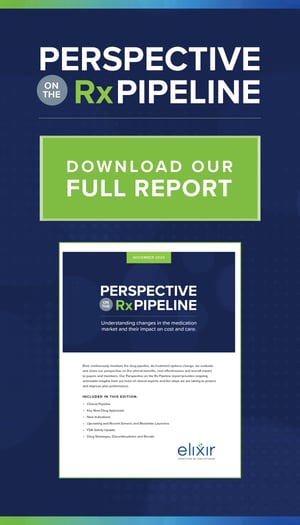From continuing revolutionary advancements in gene therapy to the ongoing effects of the COVID-19 pandemic and the search for treatments, there are a number of developments in the pipeline to watch for this year. Learn more about five key developments in this edition of Perspective on the Rx Pipeline.
Perspective on the Rx Pipeline
1. Hemophilia Gene Therapy
Hemophilia A and B are rare diseases that mainly effect males where defective proteins or a lack of certain proteins causes issues with blood clotting. Gene therapy provides functional gene replacement to those with a dysfunctional gene and can provide blood factors that can lead to significant bleed prevention in severe hemophilia patients. However, current gene therapy for hemophilia uses adeno-associated vectors (AAV) to transport the genetic code to the recipient and this method is being reviewed for side effect and safety issues. Additionally, the long-term effectiveness needed to justify the costs is unknown.
2. COVID-19 Prevention and Treatment
Despite multiple current vaccines being available for COVID-19 prevention, as of December 2021, the World Health Organization (WHO) noted 137 vaccines in clinical development, including one looking to apply for Emergency Use Authorization (EUA) in the U.S. in the coming months. Continued development of vaccines is needed to vaccinate the world. However, variants, such as Omicron, have prompted concerns with the continued long-term efficacy of current FDA-approved vaccinations against the evolving virus, making the search for treatment options also important. Sotrovimab recently received EUA and may be the most promising antibody against the Omicron variant. Several other medications are available or in development for treatment, but concerns and considerations remain.
3. Leading Oncology Medication Revlimid® (lenalidomide) Generic in the Pipeline
Revlimid, an immunomodulatory agent that kills abnormal cells in bone marrow, is an oral oncology medication approved in 2015 that has since gathered indications for multiple forms of non-Hodgkin's lymphoma, multiple myeloma, mantel cell lymphoma and myelodysplastic syndromes. It has been reported as the number one prescribed chemotherapy for myeloma and had sales over $8 billion in 2020. There are multiple generic filers for this medication seeking approval, with the earliest expected launch in March 2022. Approval of a generic should bring welcome financial relief in the oncology class; however, a recent label expansion for follicular lymphoma (non-Hodgkin) and marginal zone lymphoma may contribute to continued brand growth. Also, roll out of the generics could be slow due to volume production limitations pending on litigation and legal agreements with manufacturers.
4. Interchangeable Biosimilars... Still a Ways to Go!
Biosimilars, which offer a safe and effective alternative to the original biologic product, continue to have delayed launches due to patent litigation. In addition to biosimilars, we are now seeing long-anticipated interchangeable products coming to market, with two drugs approved to date. If pharmacy state law allows, these products may be substituted at the pharmacy level without the healthcare provider writing a new prescription for the biosimilar.
5. Pipeline PrEP and Pending Update to USPSTF Recommendations
Pre-exposure prophylaxis (PrEP) is medicine taken to prevent transmission of HIV in people that are at high risk of getting the disease. As of June 2019, the United States Preventive Service Task Force (USPSTF) endorsed these products, three of which are currently FDA approved. There are a number of PrEP drugs in the pipeline, some with new routes of administration, and the USPSTF is currently reviewing their recommendations to consider the newer routes of administration and pipeline drugs for inclusion in guidelines related to Affordable Care Act coverage.
Download the full report for more information on all of these developments.


